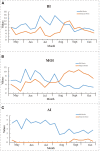Model-based risk assessment of dengue fever transmission in Xiamen City, China
- PMID: 36860401
- PMCID: PMC9969104
- DOI: 10.3389/fpubh.2023.1079877
Model-based risk assessment of dengue fever transmission in Xiamen City, China
Abstract
Background: Quantitative assessment of the risk of local transmission from imported dengue cases makes a great challenge to the development of public health in China. The purpose of this study is to observe the risk of mosquito-borne transmission in Xiamen City through ecological and insecticide resistance monitoring. Quantitative evaluation of mosquito insecticide resistance, community population and the number of imported cases affecting the transmission of dengue fever (DF) in Xiamen was carried out based on transmission dynamics model, so as to reveal the correlation between key risk factors and DF transmission.
Methods: Based on the dynamics model and combined with the epidemiological characteristics of DF in Xiamen City, a transmission dynamics model was built to simulate the secondary cases caused by imported cases to evaluate the transmission risk of DF, and to explore the influence of mosquito insecticide resistance, community population and imported cases on the epidemic situation of DF in Xiamen City.
Results: For the transmission model of DF, when the community population is between 10,000 and 25,000, changing the number of imported DF cases and the mortality rate of mosquitoes will have an impact on the spread of indigenous DF cases, however, changing the birth rate of mosquitoes did not gain more effect on the spread of local DF transmission.
Conclusions: Through the quantitative evaluation of the model, this study determined that the mosquito resistance index has an important influence on the local transmission of dengue fever caused by imported cases in Xiamen, and the Brayton index can also affect the local transmission of the disease.
Keywords: dengue fever; insecticide resistance monitoring; mathematical model; risk assessment; vector investigation.
Copyright © 2023 Guo, Liu, Liu, Abudunaibi, Luo, Wu, Deng, Yang, Huang, Wu, Lei, Zhao, Li, Li, Liu, Zhan and Chen.
Conflict of interest statement
The authors declare that the research was conducted in the absence of any commercial or financial relationships that could be construed as a potential conflict of interest.
Figures





Similar articles
-
Predicting local dengue transmission in Guangzhou, China, through the influence of imported cases, mosquito density and climate variability.PLoS One. 2014 Jul 14;9(7):e102755. doi: 10.1371/journal.pone.0102755. eCollection 2014. PLoS One. 2014. PMID: 25019967 Free PMC article.
-
Forecasting and mapping dengue fever epidemics in China: a spatiotemporal analysis.Infect Dis Poverty. 2024 Jul 3;13(1):50. doi: 10.1186/s40249-024-01219-y. Infect Dis Poverty. 2024. PMID: 38956632 Free PMC article.
-
Risk assessment of dengue fever in Zhongshan, China: a time-series regression tree analysis.Epidemiol Infect. 2017 Feb;145(3):451-461. doi: 10.1017/S095026881600265X. Epub 2016 Nov 22. Epidemiol Infect. 2017. PMID: 27873572 Free PMC article.
-
Dengue fever in Saudi Arabia: A review of environmental and population factors impacting emergence and spread.Travel Med Infect Dis. 2019 Jul-Aug;30:46-53. doi: 10.1016/j.tmaid.2019.04.006. Epub 2019 Apr 10. Travel Med Infect Dis. 2019. PMID: 30978417 Review.
-
Dengue fever and insecticide resistance in Aedes mosquitoes in Southeast Asia: a review.Parasit Vectors. 2021 Jun 10;14(1):315. doi: 10.1186/s13071-021-04785-4. Parasit Vectors. 2021. PMID: 34112220 Free PMC article. Review.
Cited by
-
Dynamics and Efficacy: A Comprehensive Evaluation of the Advanced Dengue Fever Surveillance and Early Warning System in Ningbo City, 2023.Risk Manag Healthc Policy. 2024 Aug 9;17:1947-1955. doi: 10.2147/RMHP.S470237. eCollection 2024. Risk Manag Healthc Policy. 2024. PMID: 39140008 Free PMC article.
-
Advancing knowledge of One Health in China: lessons for One Health from China's dengue control and prevention programs.Sci One Health. 2024 Nov 8;3:100087. doi: 10.1016/j.soh.2024.100087. eCollection 2024. Sci One Health. 2024. PMID: 39641122 Free PMC article. Review.
-
Epidemiological and cluster characteristics of dengue fever in Yunnan Province, Southwestern China, 2013-2023.BMC Infect Dis. 2025 Jan 21;25(1):95. doi: 10.1186/s12879-024-10403-2. BMC Infect Dis. 2025. PMID: 39838306 Free PMC article.
References
Publication types
MeSH terms
LinkOut - more resources
Full Text Sources
Medical
Miscellaneous

